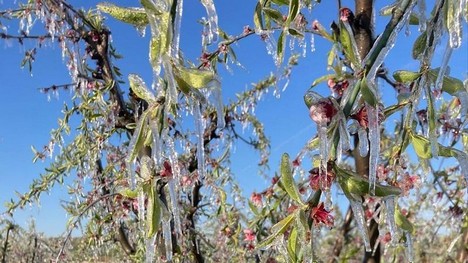Vineyards and apple orchards across the Northeast are still gauging damage from a late-season frost in May that wiped out a third to most of the crop for some growers who say it’s the worst frost damage they have ever seen.
Some states are seeking federal disaster declarations, which would make low-interest loans and other programs available to affected growers, while agriculture officials across the region are contemplating together asking the U.S. Department of Agriculture for direct aid to farmers.
In southern Vermont, Scott Farm Orchard lost up to 90% of its apple crop when the temperature dipped to 25 degrees Fahrenheit for five hours on May 18. At the northern end of the state, Shelburne Vineyards in Shelburne, Vermont, lost about 50% of its grape crop, which is potentially a half-million dollar revenue loss, according to head wine grower and vineyard manager Ethan Joseph.
To make up for lost production, Shelburne Vineyards plans to buy additional grapes at a time when its overall costs this year will be higher due to the frost, Joseph told The Associated Press. The vineyard has wine in stock to sell and it’s not off the table that it could raise prices, he said.
“We’ve never seen this kind of freeze event, certainly in the history of the vineyard,” Joseph said. “I’ve been here for 16 years. We’ve never seen anything like it.”
The widespread frost hit the large wine-producing region of the Finger Lakes in upstate New York where it’s estimated about half of the grape crop was lost regionwide, according to Kyle Anne Pallischeck, executive director of the Finger Lakes Wine Alliance. Depending on their location, some vineyards were hit hard and others had little to no damage. Vineyard owners say it’s still too early to tell what the final financial impact will be.
“I’ve been in this almost 40 years, doing it full-time and this is by far and away the worst,” said David Stamp, vineyard manager of Lakewood Vineyards, in Watkins Glen, New York, of the frost damage. He estimated their total crop loss at about 30% to 40% though it’s tough to tell since the damage is scattered throughout the vineyards. “I mean, if you put all the years together that we’ve had any damage it’s not even a quarter of what this is,” he said.
The losses will mean shorter supplies of certain wines next year and higher prices for apples this year. Some vineyards and orchards are having to reduce staff.
Keuka Lake Vineyards, in Hammondsport, New York, estimates it lost between 50% and 65% of its crop, said Mel Goldman, owner and vineyard manager. “We lost a lot,” Goldman said, adding it will take a few weeks before a final verdict as the vines produce secondary buds and shoots that could bear fruit.
Some vineyards are now starting to see growth from secondary buds, Pallischeck said. “This is where hope lies in salvaging a 2023 vintage for many,” she told the AP by email. In Vermont, Joseph said the new growth at Shelburne Vineyards is too late to produce fruit that would ripen this season.
U.S. Sens. Charles Schumer and Kirsten Gillibrand, both of New York, have asked the USDA for disaster relief for orchards and vineyards but did not specify how much was needed as damage is still being assessed. New York is the country’s second top apple-producing state after Washington.
Connecticut Gov. Ned Lamont has requested a federal agriculture disaster declaration for the state, which, if approved, would make federal disaster assistance programs, such as emergency loans, available to farmers to cover losses. Vermont’s agriculture secretary is asking agriculture officials in other New England states, as well as New York, New Jersey and Pennsylvania, to join Vermont in seeking more USDA aid, saying that without it, businesses could downsize or close, delivering devastating blows to local economies.
To try to prevent frost damage in the Finger Lakes, “some wineries ran tractors through the vineyards and a few used wind turbines to increase airflow. Others burned hay for heat or mowed the grass short in the vineyard to help keep the cold air away from the fruiting wire,” according to a statement released by Schumer and Gillibrand.
In Vermont, at least one small orchard sprayed their apple trees with water to encase them in ice to protect them from the plunging temperature, but they still lost their crop, according to Terence Bradshaw, associate professor in the plant and soil science department at the University of Vermont. Bradshaw, who also is a tree fruit and viticulture specialist, estimates Vermont lost 50% to 70% of its commercial apple crop.
The length of time that the temperature dipped below freezing was unusual but it was a confluence of circumstances — the bud stage, susceptible plant tissues that were out, and a lack of wind — that caused such damage, he said.
The late frost was rare enough that Bradshaw doesn’t think area orchards and vineyards will invest in frost irrigation or other frost protections.
Some apple growers may have a little bit more fruit than they expected, Bradshaw said. “The question is how much is enough to justify not throwing in the towel for the year and just say let’s step away, you know, cut our costs,” he said.
Source - https://www.thedailystar.com













